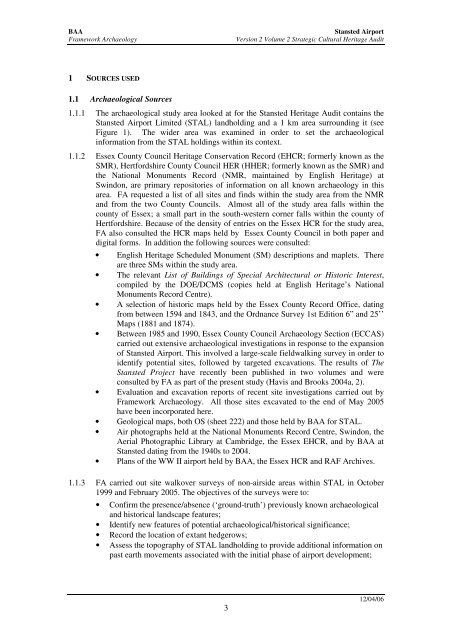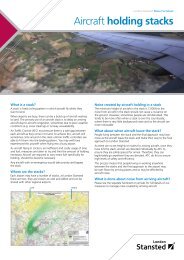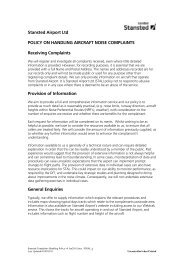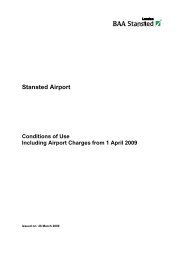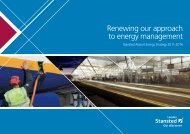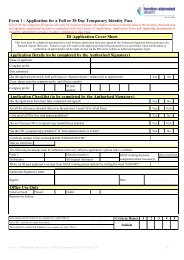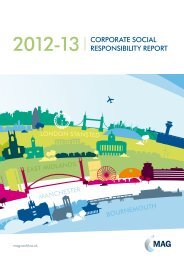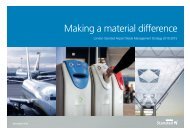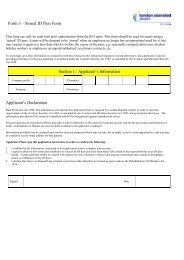Environmental-Statem.. - The future - London Stansted Airport
Environmental-Statem.. - The future - London Stansted Airport
Environmental-Statem.. - The future - London Stansted Airport
You also want an ePaper? Increase the reach of your titles
YUMPU automatically turns print PDFs into web optimized ePapers that Google loves.
BAAFramework Archaeology<strong>Stansted</strong> <strong>Airport</strong>Version 2 Volume 2 Strategic Cultural Heritage Audit1 SOURCES USED1.1 Archaeological Sources1.1.1 <strong>The</strong> archaeological study area looked at for the <strong>Stansted</strong> Heritage Audit contains the<strong>Stansted</strong> <strong>Airport</strong> Limited (STAL) landholding and a 1 km area surrounding it (seeFigure 1). <strong>The</strong> wider area was examined in order to set the archaeologicalinformation from the STAL holdings within its context.1.1.2 Essex County Council Heritage Conservation Record (EHCR; formerly known as theSMR), Hertfordshire County Council HER (HHER; formerly known as the SMR) andthe National Monuments Record (NMR, maintained by English Heritage) atSwindon, are primary repositories of information on all known archaeology in thisarea. FA requested a list of all sites and finds within the study area from the NMRand from the two County Councils. Almost all of the study area falls within thecounty of Essex; a small part in the south-western corner falls within the county ofHertfordshire. Because of the density of entries on the Essex HCR for the study area,FA also consulted the HCR maps held by Essex County Council in both paper anddigital forms. In addition the following sources were consulted:• English Heritage Scheduled Monument (SM) descriptions and maplets. <strong>The</strong>reare three SMs within the study area.• <strong>The</strong> relevant List of Buildings of Special Architectural or Historic Interest,compiled by the DOE/DCMS (copies held at English Heritage’s NationalMonuments Record Centre).• A selection of historic maps held by the Essex County Record Office, datingfrom between 1594 and 1843, and the Ordnance Survey 1st Edition 6” and 25’’Maps (1881 and 1874).• Between 1985 and 1990, Essex County Council Archaeology Section (ECCAS)carried out extensive archaeological investigations in response to the expansionof <strong>Stansted</strong> <strong>Airport</strong>. This involved a large-scale fieldwalking survey in order toidentify potential sites, followed by targeted excavations. <strong>The</strong> results of <strong>The</strong><strong>Stansted</strong> Project have recently been published in two volumes and wereconsulted by FA as part of the present study (Havis and Brooks 2004a, 2).• Evaluation and excavation reports of recent site investigations carried out byFramework Archaeology. All those sites excavated to the end of May 2005have been incorporated here.• Geological maps, both OS (sheet 222) and those held by BAA for STAL.• Air photographs held at the National Monuments Record Centre, Swindon, theAerial Photographic Library at Cambridge, the Essex EHCR, and by BAA at<strong>Stansted</strong> dating from the 1940s to 2004.• Plans of the WW II airport held by BAA, the Essex HCR and RAF Archives.1.1.3 FA carried out site walkover surveys of non-airside areas within STAL in October1999 and February 2005. <strong>The</strong> objectives of the surveys were to:• Confirm the presence/absence (‘ground-truth’) previously known archaeologicaland historical landscape features;• Identify new features of potential archaeological/historical significance;• Record the location of extant hedgerows;• Assess the topography of STAL landholding to provide additional information onpast earth movements associated with the initial phase of airport development;312/04/06


